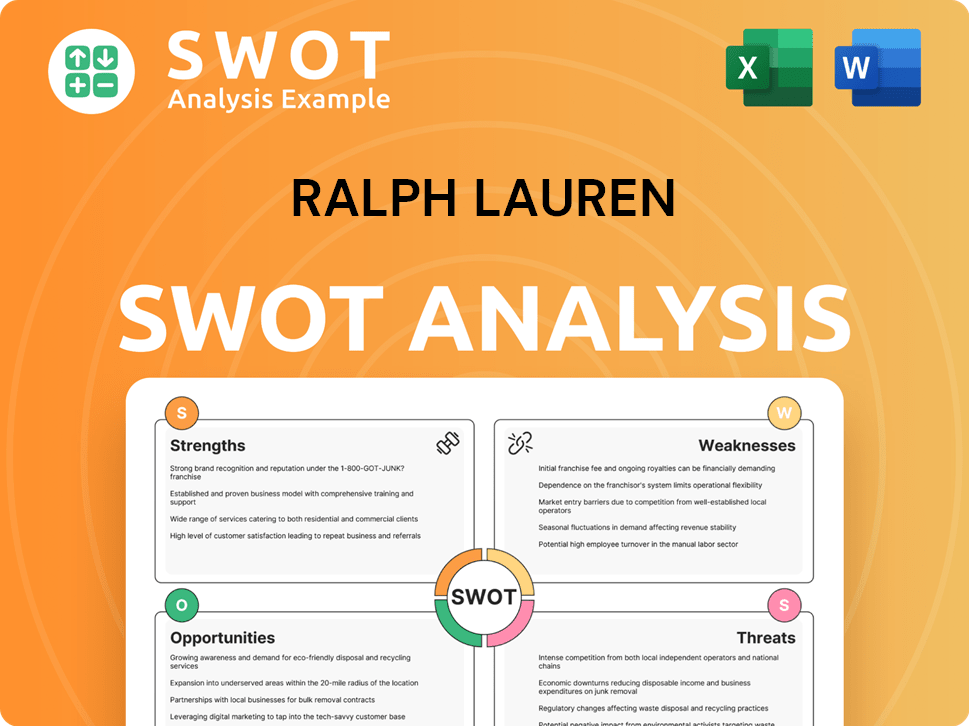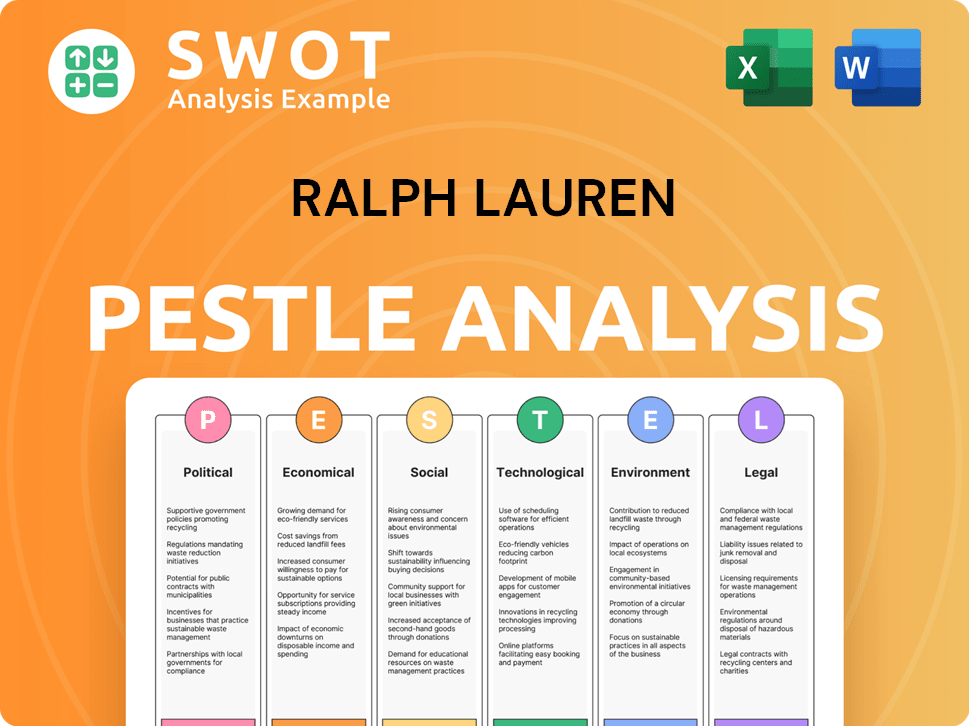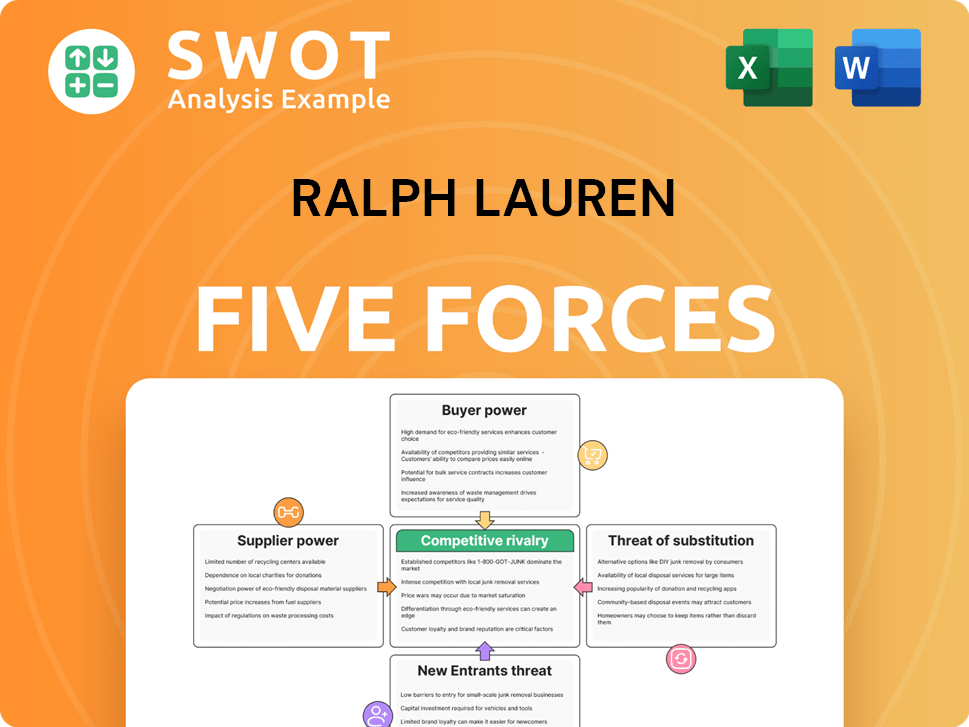Ralph Lauren Bundle
Who Buys Ralph Lauren?
Unveiling the secrets behind Ralph Lauren's enduring success starts with understanding its customers. Founded in 1967, the brand has evolved from a menswear niche to a global lifestyle powerhouse. This exploration dives deep into the Ralph Lauren SWOT Analysis, examining the core of its business strategy: its customer demographics and target market.

Ralph Lauren's fiscal year 2025 results, with $7.1 billion in revenue, underscore the importance of understanding the brand's consumer profile. This analysis will uncover the brand's market segmentation, exploring the age range, income level, and lifestyle of Ralph Lauren's ideal customer. We'll examine their buying behavior, geographic location, and interests, providing a comprehensive view of who forms the heart of Ralph Lauren's success and how the brand adapts to its target audience analysis.
Who Are Ralph Lauren’s Main Customers?
Understanding the primary customer segments for the company is crucial for its strategic direction. The brand primarily caters to affluent consumers who appreciate quality, timeless style, and luxury. The company's target market has evolved to include both men and women, reflecting a broader appeal since the introduction of its women's line.
The target demographic typically falls within the upper-middle to upper-class income brackets, possessing significant disposable income. These customers are often well-educated and fashion-conscious, willing to invest in premium products that align with their aspirational lifestyle and status. The company's approach to customer segmentation focuses on identifying and catering to these specific consumer profiles.
The company serves its customers through various channels, including retail stores, department stores, and e-commerce platforms. The company has also been focusing on attracting younger demographics, specifically Gen Z and Millennials, as part of its brand elevation strategy. This shift is essential for long-term growth, especially considering the purchasing power of these younger generations.
The company's customer base is largely composed of affluent consumers. The target market spans both genders, with a focus on individuals who value quality and luxury. The company aims to attract younger demographics, including Gen Z and Millennials, to ensure future growth.
Customers typically have upper-middle to upper-class incomes and significant disposable income. They are often well-educated and fashion-conscious. This consumer profile is key to understanding the brand's market segmentation.
The company utilizes retail stores, department stores, and e-commerce platforms to reach its customers. Direct-to-consumer sales are projected to reach 75% of total sales by fiscal year 2034. This strategic shift allows for better control over pricing and brand positioning.
The company shows strong performance in Asia and Europe, indicating significant growth in international markets. The focus on the Chinese market is crucial for future expansion. The company is also reducing exposure to US department store channels.
The company's target market analysis reveals a focus on affluent consumers who value quality and luxury. This focus is evident in its brand positioning and the consumer profile it cultivates. The strategic shift towards direct-to-consumer sales and international markets is crucial for sustained growth. You can learn more about the company's growth strategy in this article: Growth Strategy of Ralph Lauren.
- Income Level: Upper-middle to upper-class.
- Education Level: Typically well-educated.
- Lifestyle: Fashion-conscious, aspirational.
- Geographic Location: Strong presence in Asia and Europe.
Ralph Lauren SWOT Analysis
- Complete SWOT Breakdown
- Fully Customizable
- Editable in Excel & Word
- Professional Formatting
- Investor-Ready Format

What Do Ralph Lauren’s Customers Want?
The customers of the company are drawn to timeless elegance, quality craftsmanship, and an aspirational lifestyle. Their purchasing decisions are influenced by a preference for classic designs and products that convey sophistication and status. These consumers are often willing to invest in premium offerings, expecting durability and longevity. The psychological and aspirational drivers include a desire to embody the 'American dream' and associate with a brand that represents refinement and prestige.
Understanding the customer demographics is crucial for the company's success. The company effectively addresses unmet needs and pain points by consistently delivering high-quality products and adapting its offerings to evolving preferences. They use data analytics and customer feedback from social media to understand market trends and inform product development and marketing strategies. This approach helps the company maintain its relevance and appeal in a competitive market.
The brand's ability to adapt to changing consumer demands is evident in its initiatives and marketing strategies. For instance, the company has adapted to the growing demand for sustainable and ethical fashion by launching initiatives like the Earth Polo, aiming to eliminate plastic waste. Furthermore, the company tailors its marketing and customer experiences to specific segments, leading to increased customer satisfaction and loyalty.
Customers seek timeless elegance and quality. They value classic designs and products that convey sophistication. Durability and longevity are key factors influencing their purchasing decisions.
Consumers prefer classic designs and an aspirational lifestyle. They are willing to invest in premium products. The brand's ability to adapt to changing consumer demands is evident in its initiatives and marketing strategies.
Customers desire to embody the 'American dream'. They want to associate with a brand that represents refinement and prestige. The brand's image strongly influences consumer choices.
The company consistently delivers high-quality products. They tailor offerings to evolving preferences. Data analytics and customer feedback inform product development.
The company customizes marketing and customer experiences. They offer personalized recommendations based on purchase history. Loyalty programs enhance customer relationships.
The company has launched initiatives like the Earth Polo. They aim to eliminate plastic waste. Sustainability efforts align with consumer values.
The company's focus on understanding and meeting customer needs is a key factor in its success. By analyzing the customer demographics and target market, the company can tailor its products and marketing efforts effectively. The brand's ability to maintain its relevance in a dynamic market is also supported by its focus on sustainability and customer experience enhancements. To gain further insights, consider exploring the Competitors Landscape of Ralph Lauren, which provides a broader context of the competitive environment.
The company uses various strategies to enhance customer engagement and loyalty. These include personalized recommendations, in-store technology, and loyalty programs.
- Personalized Recommendations: Tailoring product suggestions based on purchase history and browsing behavior.
- In-Store Technology: Incorporating virtual try-ons and augmented reality to enhance the shopping experience.
- Loyalty Programs: Offering early access to sales and exclusive events to reinforce customer relationships.
- Collaborations: Partnering with other brands to reach new audiences while maintaining a classic style.
Ralph Lauren PESTLE Analysis
- Covers All 6 PESTLE Categories
- No Research Needed – Save Hours of Work
- Built by Experts, Trusted by Consultants
- Instant Download, Ready to Use
- 100% Editable, Fully Customizable

Where does Ralph Lauren operate?
The geographical market presence of the [Company Name] is substantial, with a strong foothold in North America, Europe, and Asia. The company strategically focuses on expanding its global footprint, particularly in high-growth markets like Asia. This expansion is supported by localized offerings and marketing strategies tailored to regional preferences.
In fiscal year 2025, Europe led sales growth with a 12% increase year-over-year, followed by Asia with a 9% increase. North America also saw growth, with a 6% increase. These figures highlight the company's diversified revenue streams and its ability to capitalize on international market opportunities.
The company's growth strategy includes significant investments in key markets, such as China, where it anticipates substantial future growth. This expansion involves new store openings and e-commerce initiatives to cater to the evolving consumer base.
In fiscal year 2025, North America experienced a 3% revenue increase, reaching $3.1 billion. This region remains a significant market for the company, with continued efforts to maintain and grow its consumer base. The company's brand positioning in North America is crucial for its overall success.
Europe demonstrated robust growth, with an 11% increase in revenue to $2.2 billion in fiscal year 2025. The company benefits from high brand awareness in key European markets, such as the UK. The Growth Strategy of Ralph Lauren focuses on adapting to local preferences.
Asia saw a 9% revenue increase, reaching $1.7 billion in fiscal year 2025, with China leading the growth. The company is actively expanding its presence in Asia through new stores and e-commerce platforms. The target market in Asia is crucial for the company's future.
The company anticipates that sales in Europe and Asia will constitute approximately 62% of total sales by fiscal year 2034, a significant increase from 53% in fiscal year 2024. This shift underscores the company's strategic focus on international markets and its commitment to adapting to local consumer behaviors.
Ralph Lauren Business Model Canvas
- Complete 9-Block Business Model Canvas
- Effortlessly Communicate Your Business Strategy
- Investor-Ready BMC Format
- 100% Editable and Customizable
- Clear and Structured Layout

How Does Ralph Lauren Win & Keep Customers?
The company employs a comprehensive strategy for acquiring and retaining customers, utilizing a blend of traditional and digital channels. Their marketing efforts are substantial, with a particular focus on digital campaigns to attract and engage consumers. The brand's approach includes leveraging social media and enhancing digital platforms to create personalized experiences.
A key element of the company's customer acquisition strategy is its strong presence on social media platforms, such as Instagram, TikTok, WeChat, and Douyin. These channels are used to showcase the brand's lifestyle, run influencer campaigns, and directly interact with audiences. The company also focuses on digital acceleration and personalized experiences to enhance its customer acquisition and retention efforts. This includes investments in e-commerce platforms and personalization initiatives.
For customer retention, the company emphasizes loyalty programs that offer exclusive benefits, aiming to strengthen long-term customer relationships. By focusing on brand elevation, product innovation, and a robust omnichannel strategy, the company aims to maintain customer loyalty and drive long-term value. Additionally, strategic partnerships and collaborations, such as with the streetwear brand Palace, help attract new, younger audiences while maintaining brand authenticity. The company added 1.7 million new consumers to its direct-to-consumer businesses in the third quarter of fiscal year 2024.
The company invests heavily in digital marketing campaigns to attract and engage consumers. This includes targeted advertising on social media and search engines. These campaigns are designed to reach specific customer demographics and promote new products.
The company uses social media platforms like Instagram, TikTok, WeChat, and Douyin to showcase its lifestyle. They run influencer campaigns and engage directly with their audiences. This helps to build a strong brand presence and connect with their target market.
The company invests in e-commerce platforms and personalization initiatives, such as tailored recommendations. They launched a full-catalog mobile app, leveraging connected retail capabilities for a more personalized experience. This enhances the online shopping experience for customers.
The company emphasizes loyalty programs that offer exclusive benefits. These programs include early access to sales and invitations to special events. This approach reinforces long-term loyalty and strengthens customer relationships.
The company's customer acquisition and retention strategies are significantly influenced by its understanding of its customer demographics and target market. The brand aims to maintain customer loyalty and drive long-term value by focusing on brand elevation, product innovation, and a robust omnichannel strategy. To learn more about the company's ownership structure and financial performance, you can read an article about Owners & Shareholders of Ralph Lauren.
The company focuses on digital acceleration to improve customer experience. This includes investments in e-commerce platforms and personalized recommendations. These efforts aim to make shopping easier and more engaging.
Personalization is a key strategy, with tailored recommendations based on customer data. The company utilizes virtual styling services and smart mirror technology. These initiatives enhance the shopping experience both online and in stores.
The company forms strategic partnerships to attract new audiences. Collaborations, like the one with the streetwear brand Palace, help expand the brand's reach. These partnerships maintain brand authenticity while drawing in new customers.
Customer data and CRM systems are used to gain insights into customer preferences. This data enables targeted campaigns and personalized services. Understanding customer behavior is essential for retention.
A robust omnichannel strategy integrates online and offline experiences. This approach ensures a seamless shopping experience across all channels. It helps maintain customer loyalty and drive long-term value.
The company focuses on brand elevation through product innovation and marketing. This strategy aims to maintain a premium brand image. It helps retain customers and attract new ones.
Ralph Lauren Porter's Five Forces Analysis
- Covers All 5 Competitive Forces in Detail
- Structured for Consultants, Students, and Founders
- 100% Editable in Microsoft Word & Excel
- Instant Digital Download – Use Immediately
- Compatible with Mac & PC – Fully Unlocked

Related Blogs
- What are Mission Vision & Core Values of Ralph Lauren Company?
- What is Competitive Landscape of Ralph Lauren Company?
- What is Growth Strategy and Future Prospects of Ralph Lauren Company?
- How Does Ralph Lauren Company Work?
- What is Sales and Marketing Strategy of Ralph Lauren Company?
- What is Brief History of Ralph Lauren Company?
- Who Owns Ralph Lauren Company?
Disclaimer
All information, articles, and product details provided on this website are for general informational and educational purposes only. We do not claim any ownership over, nor do we intend to infringe upon, any trademarks, copyrights, logos, brand names, or other intellectual property mentioned or depicted on this site. Such intellectual property remains the property of its respective owners, and any references here are made solely for identification or informational purposes, without implying any affiliation, endorsement, or partnership.
We make no representations or warranties, express or implied, regarding the accuracy, completeness, or suitability of any content or products presented. Nothing on this website should be construed as legal, tax, investment, financial, medical, or other professional advice. In addition, no part of this site—including articles or product references—constitutes a solicitation, recommendation, endorsement, advertisement, or offer to buy or sell any securities, franchises, or other financial instruments, particularly in jurisdictions where such activity would be unlawful.
All content is of a general nature and may not address the specific circumstances of any individual or entity. It is not a substitute for professional advice or services. Any actions you take based on the information provided here are strictly at your own risk. You accept full responsibility for any decisions or outcomes arising from your use of this website and agree to release us from any liability in connection with your use of, or reliance upon, the content or products found herein.